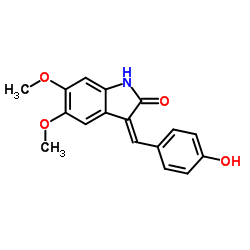RPI-1

RPI-1 structure
|
Common Name | RPI-1 | ||
|---|---|---|---|---|
| CAS Number | 269730-03-2 | Molecular Weight | 297.305 | |
| Density | 1.3±0.1 g/cm3 | Boiling Point | 533.6±50.0 °C at 760 mmHg | |
| Molecular Formula | C17H15NO4 | Melting Point | N/A | |
| MSDS | USA | Flash Point | 276.5±30.1 °C | |
| Symbol |

GHS09 |
Signal Word | Warning | |
Use of RPI-1RPI-1 is a specific, orally available 2-indolinone Ret tyrosine kinase inhibitor. RPI-1 inhibits proliferation, Ret tyrosine phosphorylation, Ret protein expression, and the activation of PLCgamma, ERKs and AKT in human medullary thyroid carcinoma TT cells. Antitumor activity[1]. |
| Name | 2H-Indol-2-one, 1,3-dihydro-3-[(4-hydroxyphenyl)methylene]-5,6-dimethoxy |
|---|---|
| Synonym | More Synonyms |
| Description | RPI-1 is a specific, orally available 2-indolinone Ret tyrosine kinase inhibitor. RPI-1 inhibits proliferation, Ret tyrosine phosphorylation, Ret protein expression, and the activation of PLCgamma, ERKs and AKT in human medullary thyroid carcinoma TT cells. Antitumor activity[1]. |
|---|---|
| Related Catalog | |
| In Vitro | TPC-1 cells are sensitive to the growth inhibitory effect of RPI-1 with an IC50 of 5.1 μM, following 72 hours of treatment. RPI-1 (7.5-60 µM) inhibits Ret/Ptc1 autophosphorylation in TPC-1 cells. RPI-1 inhibitory effects in the TPC-1 cell culture conditions lead to inhibition of pathways involving JNK2 and AKT[1]. The RPI-1 IC50 value for cell proliferation is 3.6 µM in NIH3T3 cells expressing the Ret mutant compared with 16 µM in non-transfected NIH3T3 cells, and that for colony formation in soft agar was 2.4 µM and 26 µM in RET mutant-transfected and H-RAS-transfected NIH3T3 cells, respectively. In NIH3T3 cells expressing the Ret mutant, Ret protein and tyrosine phosphorylation were undetectable after 24 hours of RPI-1 treatment. In TT cells, RPI-1 inhibits proliferation, Ret tyrosine phosphorylation, Ret protein expression, and the activation of PLCgamma, ERKs and AKT[2]. |
| In Vivo | RPI-1 (50, 100 mg/kg; p.o.; twice a day for 10 days) inhibits the tumor growth of TT xenografts by 81%[2]. Animal Model: 8- to 11-week-old female athymic nude CD-1 mice (bearing TT cells)[2] Dosage: 50, 100 mg/kg Administration: P.o.; twice a day for 10 days Result: A dose-dependent effect on tumor growth was observed, with a dose of 2*50 mg/kg/day resulting in less tumor weight inhibition than the 2*100mg/kg/day dose after 10 days of treatment. |
| References |
| Density | 1.3±0.1 g/cm3 |
|---|---|
| Boiling Point | 533.6±50.0 °C at 760 mmHg |
| Molecular Formula | C17H15NO4 |
| Molecular Weight | 297.305 |
| Flash Point | 276.5±30.1 °C |
| Exact Mass | 297.100098 |
| PSA | 67.79000 |
| LogP | 3.08 |
| Vapour Pressure | 0.0±1.5 mmHg at 25°C |
| Index of Refraction | 1.660 |
|
Proteomic Identification of DNA-PK Involvement within the RET Signaling Pathway.
PLoS ONE 10 , e0127943, (2015) Constitutive activation of the Rearranged during Transfection (RET) proto-oncogene leads to the development of MEN2A medullary thyroid cancer (MTC). The relatively clear genotype/phenotype relationshi... |
|
|
Glial cell line-derived neurotrophic factor induces cell proliferation in the mouse urogenital sinus.
Mol. Endocrinol. 29(2) , 289-306, (2015) Glial cell line-derived neurotrophic factor (GDNF) is a TGFβ family member, and GDNF signals through a glycosyl-phosphatidylinositol-linked cell surface receptor (GFRα1) and RET receptor tyrosine kina... |
| (3Z)-3-(4-Hydroxybenzylidene)-5,6-dimethoxy-1,3-dihydro-2H-indol-2-one |
| 1,3-dihydro-5,6-dimethoxy-3-((4-hydroxyphenyl)methylene)-2H-indol-2-one |
| 2H-Indol-2-one, 1,3-dihydro-3-[(4-hydroxyphenyl)methylene]-5,6-dimethoxy-, (3Z)- |
| RPI-1 |